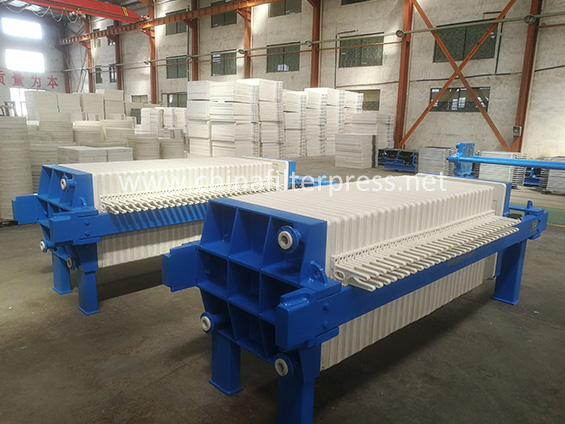
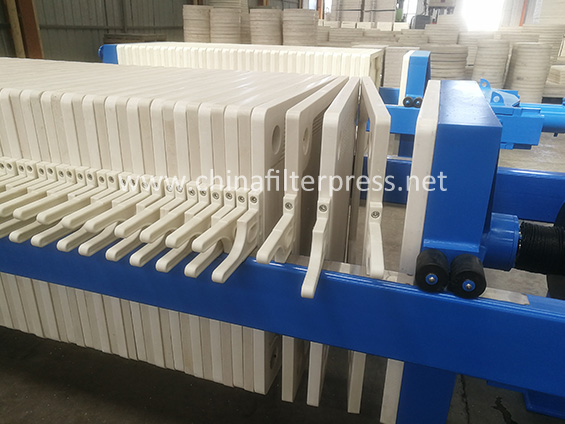
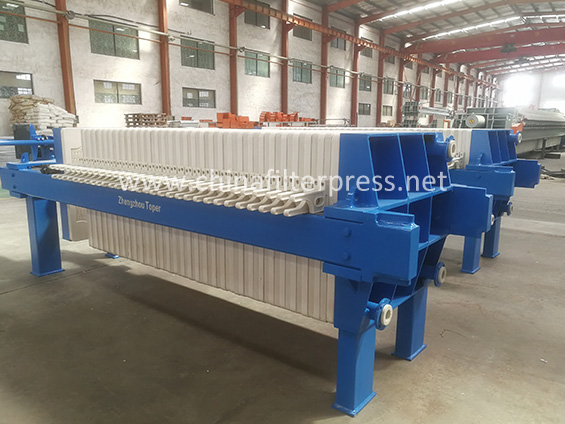
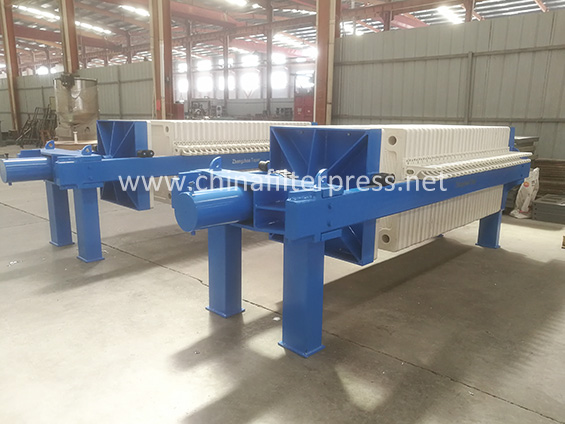
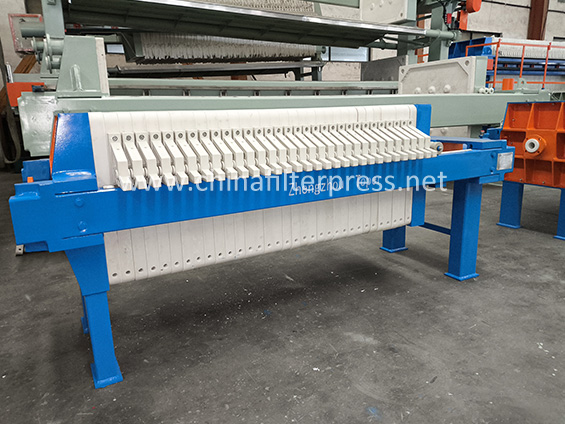
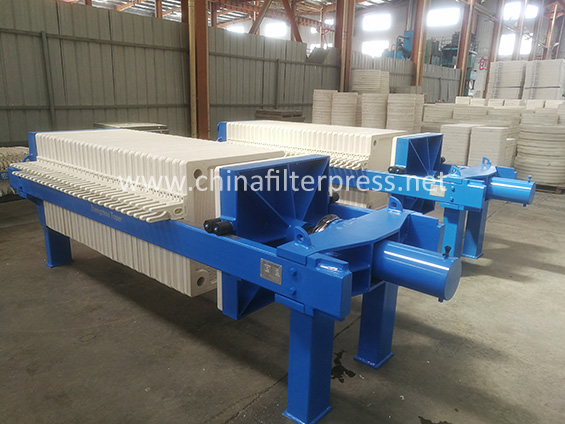








Plate and frame filter presses are the most traditional type of filter press and have been in use for many years, predating the chamber filter press, which is the type of filter press most people think of today when they hear the word "filter press." Although chamber filter presses are more common now, the plate and frame design offers some advantages in certain applications and is still used today.
Plate and frame filter presses are the most traditional type of filter press and have been in use for many years, predating the chamber filter press, which is the type of filter press most people think of today when they hear the word "filter press." Although chamber filter presses are more common now, the plate and frame design offers some advantages in certain applications and is still used today.
The plate and frame filter press adopts the structure of alternating plates and frames, which is composed of a series of alternating vertical plates and frames. The filter medium is attached to the plates, usually made of filter cloth or other porous materials. The frame fixes the plates together and provides support, and the filter cake is collected in the frame.

Currently, the filter plate of filter press is made of polymer or polymer coated steel. According to the needs, the filter plate can also choose cast iron or stainless steel materials, which provide a good drainage surface for the filter cloth. The size range of the filter plate is 250 ×250 mm to 2.0 × 2.0 meters, and larger or smaller sizes are available.
Filter press usually uses filter cloth as filter medium, which is made of polypropylene filter cloth, non-woven fabric, cotton cloth, etc. filter paper board, cotton pulp board or filter membrane can also be used as filter medium as required. Generally, the cake thickness of plate and frame filter press can reach 50 mm, but in extreme cases, it can be increased to 200 mm. The box filter press (concave filter press) can form a filter cake with a thickness of 30-40mm.
Before using the filter press for filtration, if the solid suspension has precipitated, the mixed liquid needs to be pretreated, which can improve the performance of the filter press because it increases the porosity of the filter cake, thus speeding up the filtration speed. The size of floc can be controlled by changing temperature, concentration and pH value. In addition, if the filter cake is impermeable and not conducive to the flow of filtrate, filter aids can be added in the pretreatment process to increase the porosity of the filter cake, reduce the resistance of the filter cake and obtain a thicker filter cake. However, the filter aid needs to be able to be removed from the filter cake by physical or chemical treatment. A common filter aid is diatomite, with a porosity of 0.85.
1. The plate and frame filter press sets a hollow frame between two plates to form a filter chamber. The filter medium of a general filter press is filter cloth, while the filter plate of a plate and frame filter press is flat, so in addition to the filter cloth, filter paper can also be used to achieve fine filtration or even ultrafiltration. And the filter cloth can be replaced quickly, saving time.
For example, in a process where particles need to be retained immediately, filter paper may be required because fine solids will either block the filter cloth or directly pass through the filter cloth. Note that the filter cloth is still used to support the filter paper. The filter cloth can be reused, but the filter paper must be replaced after each filtration cycle.
2.Since the plate and frame filter press does not have the support point as the chamber filter plate, it cannot withstand high filtration pressure and can only unload the cake manually, so the model is generally not large, with a maximum filter plate size of 870mm, mainly used in laboratories and fine chemical industries.
3. There are many types of compress methods for plate and frame filter presses: manual type (jack), semi-automatic (manual hydraulic compress type), automatic (hydraulic compress type), etc.; common filter plate materials include polypropylene, cast iron, stainless steel, etc.
The process of using a plate and frame filter press involves feeding the slurry mixture of solids and liquids into the filter press, which is then pumped into the space between the plates. The liquid component of the mixture, or filtrate, passes through the filter cloth or filter paper and can be collected in a tray or tank below the filter press, while the solids are trapped in the space between the plates.
Once the filtration process is complete, the filter press is opened and the filter cake (i.e., accumulated solids) is removed from the plates. The filter cloth or filter paper is then cleaned or replaced, and the filter press is ready for another filtration cycle.
Plate and frame filter press is a widely used high-efficiency filtration equipment, which is widely used in various industries such as chemical, pharmaceutical, food processing and wastewater treatment.
Wastewater treatment: In wastewater treatment plants, it separates solids from sludge, reducing treatment costs and environmental impact.
Food and beverage industry: For food processing, it can clarify liquids and extract solids, ensuring product quality and meeting hygiene standards.
Chemical industry: In chemical processes, it filters and separates various chemical compounds, helping to improve the purity and quality of products.
1.Auto bomb door : When the filter press is filtering, there may be dripping between the filter plates due to the capillary penetration of the filter cloth; the auto bomb door system will collect the leaked liquid, which not only avoids pollution at the work site, but also avoids the increase of moisture in the filter cake under the filter press.
2.Mud collection cart: The material is usually carbon steel or stainless steel. The bottom is equipped with universal wheels for easy movement. Placed under the filter plate of a small filter press, it can be used to collect filter cakes for easy transportation.
3.Sludge storage bucket : Used to collect the filter cakes removed after filtration for easy transportation. The opening methods are divided into electric and pneumatic.
4.Belt conveyor: Used to transport the discharged filter cake, it is placed under the filter press to transport the filter cake to the designated location, thus reducing labor intensity.
| Type | Filter area (m2) |
Filter plate size (mm) |
Filter cake thickness (mm) |
Filter chamber volume (L) | Filter plate number (PCS) |
Filter frame number (PCS) |
Filtrating pressure (MPa) |
Motor power (KW) |
Dimension (mm) (L×W×H) |
| BY4/450-30U | 4 | 450×450 | 30 | 60 | 9 | 10 | 0.6 | 2.2 | 2080×800×900 |
| BY6/450-30U | 6 | 91 | 14 | 15 | 2380×800×900 | ||||
| BY8/450-30U | 8 | 121 | 19 | 20 | 2680×800×900 | ||||
| BY10/450-30U | 10 | 151 | 24 | 25 | 2980×800×900 | ||||
| BY12/450-30U | 12 | 182 | 29 | 30 | 3280×800×900 | ||||
| BY15/450-30U | 15 | 225 | 36 | 37 | 3700×800×900 | ||||
| BY16/450-30U | 16 | 243 | 39 | 40 | 3880×800×900 | ||||
| BY15/630-30U | 15 | 630×630 | 226 | 18 | 19 | 2840×1200×1100 | |||
| BY20/630-30U | 20 | 297 | 24 | 25 | 3200×1200×1100 | ||||
| BY30/630-30U | 30 | 452 | 37 | 38 | 3980×1200×1100 | ||||
| BY40/630-30U | 40 | 595 | 49 | 50 | 4800×1200×1100 | ||||
| BY30/870-30U | 30 | 870×870 | 460 | 23 | 24 | 3570×1385×1300 | |||
| BY40/870-30U | 40 | 595 | 30 | 31 | 4050×1385×1300 | ||||
| BY50/870-30U | 40 | 748 | 38 | 39 | 4710×1385×1300 | ||||
| BY60/870-30U | 50 | 902 | 46 | 47 | 5270×1385×1300 | ||||
| BY70/870-30U | 60 | 1056 | 54 | 55 | 5830×1385×1300 | ||||
| BY80/870-30U | 70 | 1210 | 62 | 63 | 6390×1385×1300 |